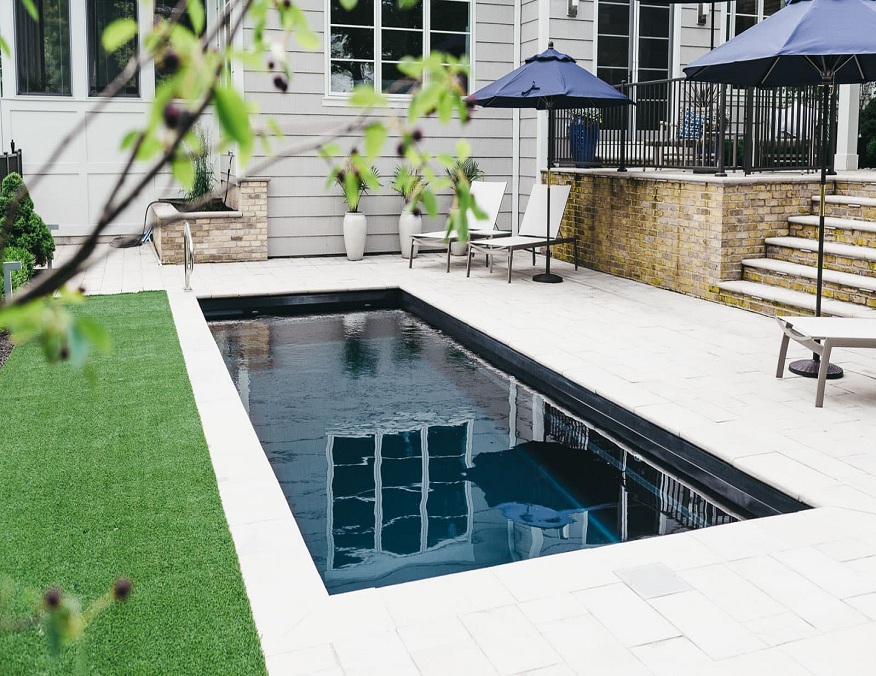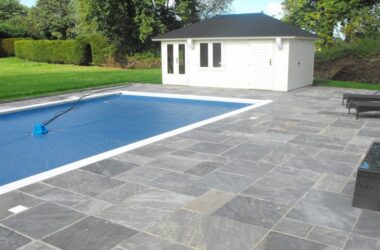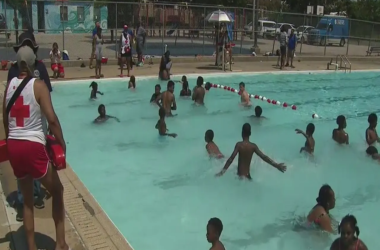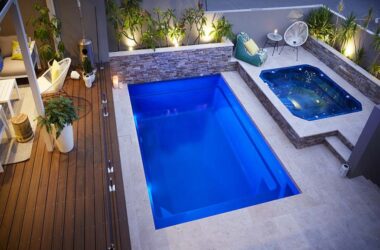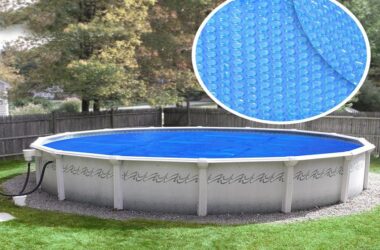When I was growing up in Australia the pools were cold, rough, sometimes murky and often had a strong stench of chlorine. As pool owners became more educated and technology advanced, the swimming experience has improved, as has the structure and longevity of swimming pools. The most popular types of swimming pools are made from fibreglass or concrete. The swimming pools of today are a lot different to those which were around in the 80s.
When you decide to invest in a swimming pool, you will need to take some time to compare and decide which type is best for you. Along with the consideration of the timing of installation, money, physical space and different shapes, you will have to make the decision of which type of pool to add into your yard.
Fibreglass swimming pool:
Firstly it’s worth noting that because fibreglass material heats up more, the swimming pool retains the heat better, so it is warmer! Also a lot of people feel at risk of grazing their skin on any edges which they may find sharp in concrete pools. Fibreglass pool’s have a smooth gelcoat non-abrasive finish, which solves that problem!
In terms of the costs for ongoing maintenance,that hi-tech gelcoat technology means that the smooth and non-porous has less opportunity for mould and algae to grow.This means there will be minimal cleaning and you’ll need less chemicals to balance out your pool. So that means less money spent on chemicals, and less time treating and cleaning the pool.
The heavy-duty fibreglass pools are made from very strong building material.
The installation process of a fibreglass pool is a lot quicker than a concrete pool. This is because the fibreglass pool is ‘ready made’ in the manufacturing facility and then they are lifted into place. To start, your backyard will need to be excavated, and then once the pool has been installed, it will be filled with water and then the dirt backfill around the pool. Then finally the installation of your pump and filtration.
Lot’s of added extras can be included onto a fibreglass pool as well. However, because they are mass produced, it means you are restricted to the standard options, and will never own a unique ‘one-off’ designer pool. You will
have more freedom with design with concrete pools, as they can be created to suit your personal requirements.
Most importantly please note that with the pricing factor, fibreglass pools are definitely the most cost effective, this is because the installation process is less labour intensive and also because the pools are prefabricated in bulk.
Concrete swimming pool:
If you are on a strict time frame, or are just impatient- a concrete pool may not be a good option for you. A concrete inground pool needs to be built from scratch, so can take as long as three months to be installed.
In the beginning the machinery will have to dig the pool hole, and then pour the concrete. Once the concrete is in, it will need to be sprayed and left to cure. Then comes the arduous and hard graft work like tiling, paving, fencing and the other finishing details. You might be surprised to find out that a concrete swimming pool could take several months from start to finish! And while a lot of Australia does benefit from an all-year-round warm climate, don’t forget those summer storms! The weather can really impact, and slow down or even halt your concrete pool installation. Plus there could be further costs associated with waterlogged soil, and getting the water drained out!
Because of their uniqueness, concrete pools are up to 30% more expensive. This is because they are built from scratch, customised specifically for an individual customer. Concrete pools can also appear more appealing, especially with the fact you can choose your own aesthetics such as pebbles and tiles. It is very strong and sturdy so you don’t need to worry about it being
damaged by sharp objects. However concrete is not compatible with all soil types. So be aware that if the soil isn’t compacted enough or is unstable, the pool itself may start to sink or crack.
The concrete can cause complaints and injuries from the harsher surfaces. Many people with concrete pools choose pebbles or stone which can be rough on the feet. Quite often people complain of grazes and cuts, especially children who love to run amuck in the pool. A concrete pool also requires more chemicals and scrubbing. Especially over the summer months because the bacteria and algae is drawn to the concrete walls and floor, as they are more absorbent surfaces. Homeowners of concrete pools also tend to spend more money on chemicals because algae can grow much easier compared to fibreglass.
Also, please note that with concrete, the swimming pool will require an expensive resurface or acid wash every seven to twelve years. This is where strong acids are used to strip the outer layer of the pool. It can be a messy and very time-consuming process.
Concrete pools have more of a scope for variety with different colours and interior textures. It can be painted or tiled but with fibreglass pools you’re limited on colour options.
Are you going to choose Fibreglass or Concrete?
While it looks as though fibreglass pools have the winning edge over concrete pools, it is ultimately your choice and you need to be comfortable with any decision you make. In recent years, over 50% of Australians are now choosing fibreglass pools, and when you look at all the information presented above, it is no surprise why. If you need further advice, speak to the team of experts at Fibreglass Pools Melbourne or check out our list of fibreglass pools FAQ’s – whatever the case, we would be happy to help!

